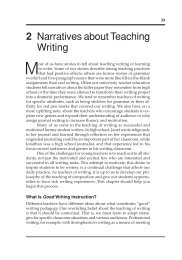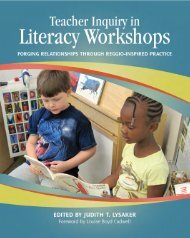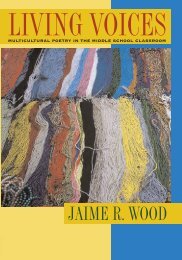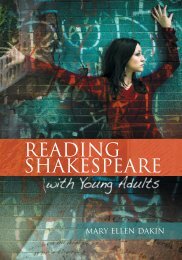Graphic novel Spread - National Council of Teachers of English
Graphic novel Spread - National Council of Teachers of English
Graphic novel Spread - National Council of Teachers of English
- No tags were found...
Create successful ePaper yourself
Turn your PDF publications into a flip-book with our unique Google optimized e-Paper software.
20 James Bucky Carter<br />
tial <strong>of</strong> graphic <strong>novel</strong>s, you will also let it help you win administrative<br />
battles that I didn’t even see coming.<br />
Later that same school year, I led my sixth graders in creating<br />
“how-to” comic books (for example, “how to bake cookies,” “how to<br />
wash a car”) and biographical sequential narratives based on historical<br />
figures that were important to them (e.g., The Wright Brothers, Clay<br />
Aiken, Kenny Chesney). I couldn’t teach the particular graphic <strong>novel</strong> I<br />
had wanted to share with my students, but I would teach my students<br />
to produce and publish (for the other grade 6 classes, anyway) their own<br />
comic!<br />
Climbing the Hill: Others’ Problems with <strong>Graphic</strong> Novels<br />
This example <strong>of</strong> “cat and Maus” perfectly illustrates the hill that proponents<br />
<strong>of</strong> the graphic <strong>novel</strong> are still climbing in many areas. Perhaps it is<br />
the relative newness <strong>of</strong> the format or the mature themes addressed by<br />
most graphic <strong>novel</strong>s that some teachers and administrators find so unsettling.<br />
Who knows Maybe there is still fallout from Frederic Wertham’s<br />
infamous 1954 text (now widely debunked), Seduction <strong>of</strong> the Innocent,<br />
in which the McCarthy-era doctor explains that comics contribute to<br />
social decay by supporting violence and homosexuality. But this seems<br />
a stretch. Although plenty <strong>of</strong> the horror and crime comics on the market<br />
in the 1950s would still give conservative parents cause for alarm,<br />
Wertham focused too much on the superhero genre, which, at the time,<br />
was far from morose or delinquent. Perhaps it is the word-picture association<br />
itself that is disturbing. Maybe teachers feel that comics are<br />
too “childish” for students (Marsh & Millard, 2000; Weiner, 2004), regardless<br />
<strong>of</strong> evidence to the contrary. The basis <strong>of</strong> teachers’ cautions about<br />
accepting graphic <strong>novel</strong>s as classroom material is another area where<br />
much research is needed. Until we understand the problem, we cannot<br />
ask teachers to accept our solutions. But we can give them as large and<br />
practical an arsenal <strong>of</strong> resources as possible. That is another goal <strong>of</strong> the<br />
book you are reading.<br />
Conclusions<br />
Obviously, more research needs to be conducted on almost every aspect<br />
<strong>of</strong> using graphic <strong>novel</strong>s for enhancing literacy. More quantitative<br />
research is needed to show correlations between graphic <strong>novel</strong>s and<br />
increased literacy skills. The theory, in other words, needs more practice.<br />
More qualitative data are needed as well. As yet, there is no study<br />
that thoroughly examines teachers’ beliefs and attitudes concerning
















